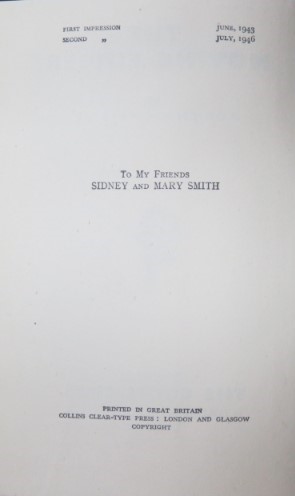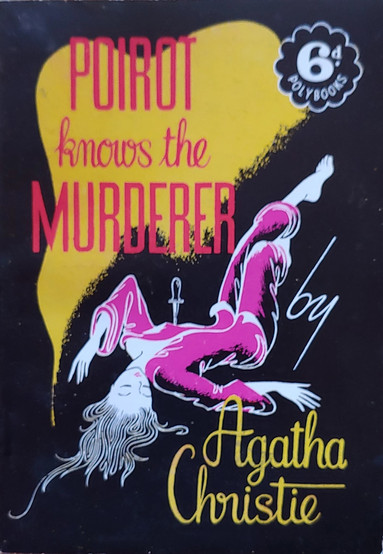COLLECT: Agatha Christie's The Moving Finger.
- David Morris
- Mar 5, 2023
- 7 min read
Updated: Jan 20, 2024
For the last few years Agatha Christie Limited has promoted reading (or re-reading) Christie books through their Read Christie campaigns. Each month a different novel is selected that will be a focus for their online book club. For March 2023, the chosen book is The Moving Finger.
Written during World War II, Christie later stated that this book was one of her favourites:
"I find that another one I am really pleased with is The Moving Finger. It is a great test to re-read what one has written some seventeen or eighteen years before. One's view changes. Some do not stand the test of time, others do."
First Appearance:
The novel's first publication was the US serialisation in Collier's Weekly in eight instalments from 28 March tp 16 May 1942 (Vol. 109, No. 13 - 20). However, it was heavily abridged and thus not the complete story as Christie wrote it. They even abridged the title... to just Moving Finger. The cover of the magazine is certainly evocative of the times and reminds the modern reader that Christie wrote this novel during a time of uncertainty when many wondered who their neighbours were and suspicion of those new to a community was rife.

The UK serialisation was also as an abridged version in six parts in Woman's Pictorial from 17 October to 21 November 1942 (Vol. 44, No. 1136-1141) also titled just Moving Finger. These magazines are exceptionally difficult to find likely due to the paper drives that were so prevalent during the war.
First Book Printings:
The first hardcover publication was in July 1942 by Dodd, Mead and Company, New York, USA. The U.S. edition retailed at $2. This was still an abridged version of the novel.

It was not until Collins published their hardback that the full manuscript Christie wrote made it to print. Collins’ first impression was published in June 1943. Priced 7s 6d net on the front flap with the correct first state jacket promoting Christie’s Five Little Pigs on the rear panel. This was the thinner style book with orange cloth. Ever since Evil Under the Sun, paper rationing had brought an end to the thinker Collins books of the 1930s.
Rather than printing export editions domestically, Collins also printed the book in two other locations. One was in Dunedin, New Zealand. The book is undated and has blue cloth, yet the dust jacket is identical to the UK first impression. Given the war, Collins did seek to publish books for the export market outside the UK. For collectors, this is to be considered a first edition thus, but with variant cloth and credit given to a different publisher.
Another 'first edition' was printed in the Netherlands. As the images below show, the font on the spine is slightly different when compared to the UK printing (left) and the copyright page is otherwise identical. As I've hypothecated before, it is likely Collins had challenges shipping books overseas during WWII and publishing books on the continent improved their distribution. Thank you to Geraint Evans at Swansea University for providing these images and adding this piece of knowledge to the article.
It addition to three first editions, there are also two known reprints that both claim to be second impressions. One is dated July 1946 and states it is printed in England. The other is dated December 1947 and states it was printed in the Netherlands. The July 1946 2nd impression is known to have an identical jacket to the correct first state jacket with one difference – it was priced 4s 6d net. Thus, it is highly likely that some copies of this jacket have ended up being price clipped and married to a first state UK printing. Consequently, UK firsts with clipped jackets are far less appealing than those showing the correct 7s 6d price.
Collins’ second impression [sic] published in December 1947 had a slightly different jacket. While cover art was the same, not only was it also priced 4s 6d net but the rear panel of the jacket promoted other Crime Club authors from Miles Burton to Alice Tilton. There was no promotion of Five Little Pigs.
It is surprisingly that this second impression [sic] was printed in the Netherlands but perhaps this was due to paper rationing in England. While World War II had ended, rationing did not end until June 1953. Other Collins books are also known to have been published in the Netherlands, such as the August 1949 White Circle paperback printing of Sad Cypress.
First Paperback Books:
1943: The first paperback publication was in 1943 by Collins under their White Circle Services Edition series. Numbered c219, this Services Edition was destined for distribution primarily to the armed services of the UK (image below left).
1947, April: Collins White Circle, number 164c. The first UK printing for sale to the general public. It was reprinted in 1958 by the Collins White Circle brand, now as number 274c (image below right).
1948: Pan books, UK. Number 55. One of the five Christie’s included in Pan’s first 100 titles, all published in the late 1940s. Aside from the first Christie, the other four all shared the same graphic design with the black top to the cover. This book had art by noted cover artist Reina Mary Sington (aka Reina M. Bull). However, it should be noted she self-plagiarized by repurposing the cover art she did for the cover of Poirot Knows the Murderer (Polybooks, 1946). Both images below - her original on the right!
She also did the cover for Poirot Lends a Hand (Polybooks, 1946).
1949: Avon, USA. number 164. First American paperback. Boldly stating "complete and unabridged" despite missing about 20% of the complete novel (see the discussion below on ‘National Variants’). In fact most American paperbacks remained abridged but continued to claim to be complete.

Other Paperbacks of Note:
1950: Pan books. Now with cover art by George Woodman and priced 1/6.
1952: Pan books. With different cover art, now from an unknown artist. Priced 2/-.
1953: Penguin Books, UK. In their standard “white stripe” format, numbered 930. This printing also states "mystery and crime" on the cover. It was reprinted as a second printing in 1954, which lacks the reference to "mystery and crime".
1955: Avon, USA. Now published under the title “The Case of the Moving Finger”. Number 636,
1960: Avon, USA. Still under the expanded title, now published as number 793.
1961: Fontana Books, UK. The first Fontana imprint. Of note, Fontana placed the price of 2/6 in the bottom right corner for books sold in the UK. Exported paperbacks had the initials ‘fb’ in that location.
1965: Fontana, UK. This was the first Fontana version to use the Tom Adams artwork he created in 1964. It was reprinted numerous times. The limited edition print, signed and dated 2012, (below right) was a generous gift from Tom Adams and a treasured part of our personal collection.
The US ‘National Variant’:
In a prior article we wrote, titled ‘National Variants’, we discussed how many US books from this era were more closely related to the text used in the serialised magazine publications than Christie's complete manuscript. The Moving Finger is one of these national variants. While the title did not change, the US published book is substantially different from the UK printing. Most American editions have close to 20% of the content redacted and the text closely resembles the Collier's serialization. It is particularly galling that Avon Books even states on the front of their paperbacks “complete and unabridged”. While it may be unmodified from the Dodd Mead version, it is still missing about 9000 words! Hardly complete. For example, the US book omits the whole of Chapter 1, part I, which is five full pages at the start of the novel that provides a lot of the background to the characters and sets up the story narrative. These large-scale omissions continue throughout the US version. Because of this, while the title remains the same these are two very different novels and anyone who has only read the US edition should seek a UK version in order to experience the full novel as Christie wrote it.
The Mercury Mystery Imprint:
The US imprint Mercury Mystery published an abridged, not standard size paperback of The Moving Finger which was priced at 25 cents. However, it did not cite a publication year.

They only used the original US copyright date of 1942. This can lead to confusion as to whether it is a first paperback. If one of our readers has the exact date of publication please share it with us. The paperbacks issued by Mercury Mystery consistently failed to have a publication date but generally appeared after the more common US printers published their paperbacks Thus, it is believed to have been printed circa 1950.
Hardback Values:
The first edition (Dodd, Mead & Co, USA) is surprisingly uncommon and scarcer than the Collins printing. In fact many of the Red Badge Detective editions from this period are as Dodd Mead promptly sold the rights of many of their books to Grosset or moved them to their cheaper ‘book club’ versions. Expect to pay $1,200 or more for a very good copy in jacket when one appears for sale (Heritage Auction, 2019: a copy sold for $1,000 plus buyer’s premium).
The first Collins (UK) edition in near fine condition is fairly valued at £800 ($1,000). This used to be a common book to find but is becoming scarce. It is highly likely that a patient collector will be able to obtain a copy at this price. However, as discussed above many firsts have been reshod in the later jacket so be cautious that the jacket is priced 7s 6d net and has the promotion of Five Little Pigs on the rear (Heritage Auction, 2019: A copy sold for $875 plus buyer’s premium).
Paperback Values:
The early White Circle paperbacks do command a premium, especially the Services Edition which can sell for £50 or more. The original Pan will generally command a premium, perhaps up to £25. Most other paperbacks all are priced as typical used books and can be found in very good or better condition for £10 ($15). Of these, we find the first Tom Adams 1965 Fontana printing to be highly appealing for the price-conscious collector as it is starting to become less common.
Happy Hunting!
Note: All the data regarding printings, editions and dates is to the best of our knowledge. Since we have not seen every edition in person, some specifics are missing. Those that are provided are accurate. Any information that fills in the gaps or other updates from our readers is most welcome. They can be sent to CollectChristie@gmail.com.








































